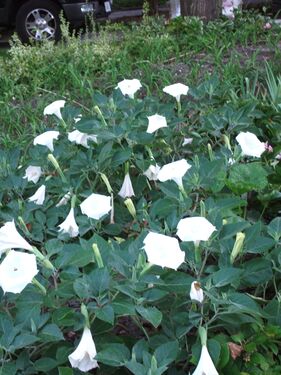Datura
Read about Datura in the Standard Cyclopedia of Horticulture
|
|---|
|
{{{1}}} The above text is from the Standard Cyclopedia of Horticulture. It may be out of date, but still contains valuable and interesting information which can be incorporated into the remainder of the article. Click on "Collapse" in the header to hide this text. |
| Datura | ||||||||||||
|---|---|---|---|---|---|---|---|---|---|---|---|---|
 Datura stramonium | ||||||||||||
| Plant Info | ||||||||||||
|
| ||||||||||||
| Scientific classification | ||||||||||||
| ||||||||||||
| Species | ||||||||||||
Datura is a genus of 12-15 species of vespertine flowering plants belonging to the family Solanaceae. Their exact natural distribution is uncertain, due to extensive cultivation and naturalization throughout the temperate and tropical regions of the globe, but is most likely restricted to the Americas, from the United States south through Mexico (where the highest species diversity occurs) to the mid-latitudes of South America. Some species are reported by some authorities to be native to China, but this is not accepted by the Flora of China, where the three species present are treated as introductions from the Americas. (It also grows naturally throughout most of Australia).
Common names include jimson weed, Hell's Bells, Devil's weed, Devil's cucumber, thorn-apple (from the spiny fruit), pricklyburr (similarly), and somewhat paradoxically, both angel's trumpet and devil's trumpet (from their large trumpet-shaped flowers), or as Nathaniel Hawthorne refers to it in the the Scarlet Letter apple-peru. The word Datura comes from Hindi dhatūrā (thorn apple); record of this name dates back only to 1662 (OED).
They are large, vigorous annual plants or short-lived perennial plants, growing to 1-3 m tall. The leaves are alternate, 10-20 cm long and 5-18 cm broad, with a lobed or toothed margin. The flowers are erect or spreading (not pendulous), trumpet-shaped, 5-20 cm long and 4-12 cm broad at the mouth; color varies from white to yellow, pink, and pale purple. The fruit is a spiny capsule 4-10 cm long and 2-6 cm broad, splitting open when ripe to release the numerous seeds.
Datura species are used as food plants by the larvae of some Lepidoptera species including Hypercompe indecisa.
Species
- Datura bernhardii
- Datura ceratocaula
- Datura discolor - Desert Thorn-apple
- Datura ferox
- Datura inoxia or Datura innoxia - Angel's Trumpet
- Datura kymatocarpa
- Datura lanosa
- Datura leichhardtii (syn. D. pruinosa) - Leichhardt's Datura
- Datura metel
- Datura quercifolia - Oak-leaf Thorn-apple
- Datura reburra
- Datura suaveolens - Known in Costa Rica as "Reina de la noche" (Night's Queen)
- Datura stramonium (syn. D. inermis) - Jimsonweed, Thorn-apple
- Datura wrightii - Sacred datura, Sacred Thorn-apple
Some species formerly included in Datura are now classified in the separate genus Brugmansia; this genus differs in being woody, making shrubs or small trees, and in having pendulous flowers. Other related genera include Hyoscyamus and Atropa.
Cultivation and uses
Datura contains the alkaloids scopolamine and atropine and has long been used as a poison and hallucinogen. The dose-response curve for the combination of alkaloids is very steep, so people who consume datura can easily take a potentially fatal overdose, hence its use as a poison. In the 1990s and 2000s, the United States media contained stories of adolescents and young adults dying or becoming seriously ill from intentionally ingesting datura.[1]
Records of use
Datura stramonium is also called jimsonweed. This name comes from the town of Jamestown, Virginia. Various versions of the story exist, but in the most common version, British soldiers sent to quell Bacon's Rebellion of 1676 were accidentally served this unfamiliar plant as food, causing many to be incapacitated for 11 days. Datura wrightii, also called sacred datura or western jimsonweed, has similar effects.
Perhaps the most famous account of jimsonweed intoxication is given in The Teachings of Don Juan: A Yaqui Way of Knowledge by Carlos Castaneda. The narrator records several experiences with the subtly addictive "devil's weed", which his mentor describes as having power similar to that of a woman:
| “ | She is as powerful as the best of allies, but there is something I personally don't like about her. She distorts men. She gives them a taste of power too soon without fortifying their hearts and makes them domineering and unpredictable. She makes them weak in the middle of their great power. | ” |
The effects of Datura can be extreme, leading to a complete inability to differentiate reality from fantasy. Many experience accounts can be found at www.erowid.org.
In film
Notes and references
- ↑ "Suspected Moonflower Intoxication (Ohio, 2002)" (HTML). CDC. Retrieved on September 30, 2006.
External links
- JimsonWeed: History, Perceptions, Traditional Uses, and Potential Therapeutic Benefits of the Genus Datura HerbalGram. 2006;69:40-50 © American Botanical Council by Kofi Busia & Fiona Heckels
- tratamientos Datura - Floripondio
- Germplasm Resources Information Network: Datura
- USDA Plant Profile: Datura
- Flora of China: Datura
- Account of accidental minor poisoning by Datura from the British Medical Journal
- Erowid Datura Vault
- Datura and Brugmansia species as Sacred Plants and Medicines
- Clinical Toxicology Review of Datura Poisoning
- Jimsonweed pictures and description at blackturtle.us
- [http://www.youtube.com/watch?v=fo6ekBEXGLQ Humorous song and discussion at YouTube: Moonflo
wer]







